“How to play table tennis” is a tricky question. The answer is related to the intention of the question. Is your intention for recreational play or you are taking table tennis on a serious note?
If it is for recreation, it is not a must for you to know all the rules of table tennis and to be a master to deal with the spin at your will. But if you are serious, you have to go through a step-by-step process that starts with learning the basic skills in table tennis and ends with advanced skills.
Whatever your intention is, I am trying to answer your quarry about “How to play table tennis” with the very basic idea of table tennis that will grow your interest and also suffice all your requirements to start playing and enjoy this wonderful game of table tennis.
But if you are hungry to know more, check my article “Basic Skills in Table Tennis: A Beginner’s Learning” for more coverage of the technical details.
The journey of table tennis play starts with the proper holding technique and ends with the match play.
- Knowledge of the Equipment
- Know the Table Tennis Grip
- Develop Stance and Ready Position
- Develop Footwork in Table Tennis
- Backhand Push, 1st Basic Stroke
- Learn Forehand Drive, 2nd Basic Stroke
- Backhand Drive, 3rd Basic Stroke
- Forehand Push, Last Basic Stroke
- Know the Basic Service Rules for Singles Game
- Know the Service Rules for Doubles
- Table Tennis Rules for Singles, an Essential Learning
- Know the Rules for Doubles Game
- Learn the Basic Serve
- Learn the Techniques to Return a Ball
- Play Frequent Matches
How to Play Table Tennis
There is a very good visual basic explanation of “How to play table tennis” from eHowSports.
“How to play table tennis” is a sequential learning process for beginners that involves 15 steps starting with the table tennis grip and ending with match play.
1. Knowledge of the Equipment
There are mainly four types of equipment that you require to play table tennis.
- Table tennis table
- Table tennis net
- One table tennis racket
- Table tennis ball
The selection of your racket is very important. As a beginner, you must concentrate on control rather than speed and spin, and for this, the selection of racket is a key factor.
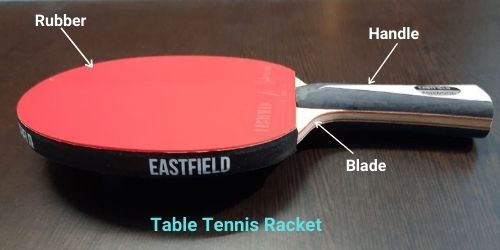
A racket consists of the blade and rubber and they determine the characteristics and quality of the racket.
The racket may be ready-made or customized. As a beginner, a ready-made racket suffices for your requirements. As you upgrade your level of play, you may opt for customized rackets.
For the ready-made racket, three things are essential for the selection.
- No. of layers of wood in the blade
- Type of the handle
- The thickness of the rubber
- Three attributes, spin, speed, and control
No. of layers of wood in the blade
The number of layers of wood determines how much speed the racket can generate. There are three types of layers of wood available in the market, 3 layers, 5 layers, and 7 layers. The rackets with higher layers generate more speed and rackets with lower layers are famous for control.
As a beginner, your focus should be more on the control part not speed. So the racket with 3 or 5 layers of wood would be perfect for you.
Type of the handle
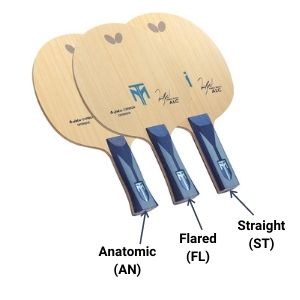
In the racket, you will find three types of handles.
- AN- Anatomic
- FL – Flared
- ST – Straight
For a beginner, the flared type of handle will give the best result.
The thickness of the rubber
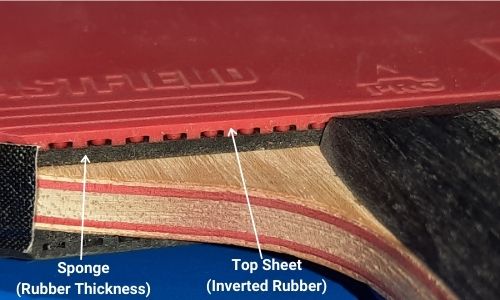
The thickness of the rubber has a major contribution to the characteristics and performance of the racket.
In general, the thickness of the rubber varies from 1.0 mm to 2.3 mm. The more the thickness of the rubber, the more will be the speed whereas less thick rubbers are better for control.
As a beginner, choose the rubbers with medium thickness (1.5 mm – 1.9 mm). It will be ideal for you to give you the best result.
Three attributes, spin, speed, and control
When you check the specification of any racket, notice the rating on the three attributes, i.e. speed, spin, and control which determine the characteristics of the racket.
Favor the rackets with more weightage on control, rather than speed or spin.
2. Know the Table Tennis Grip
The most fundamental learning on “how to play table tennis” for a beginner, is the proper table tennis grip. A proper grip helps you fix the angle of your racket. You have control over the placement of the ball.
In table tennis, there are mainly two types of grips. One is a Shakehand grip and the other one is a Penhold grip.
Shakehand Grip
As the name suggests, in a Shakehand grip, try to hold the bat in a way that you are shaking hands.
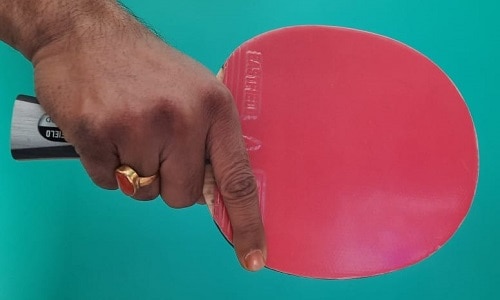
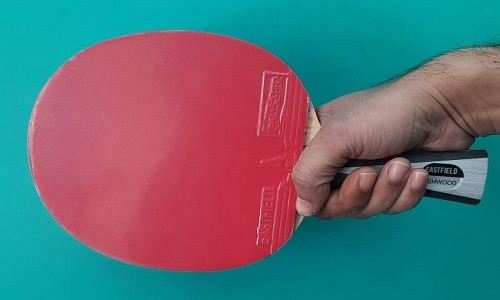
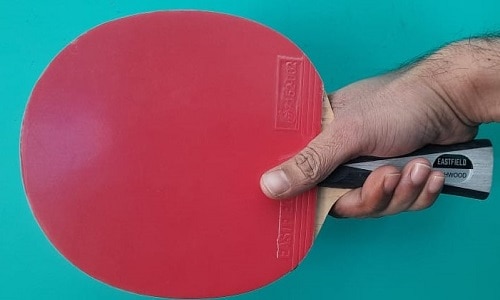
- As in the figure above, hold the upper part of the handle with the middle finger, ring finger, and pinkie.
- Place your index finger on the edge of the rubber ( As shown in the figure above).
- Your thumb should be either on the blade just below the rubber or on the surface of the rubber.
- When the thumb is on the blade, you have more freedom over the racket angle and you can adjust it as per your requirement on the stroke selection. This is the shallow Shakehand grip that is suitable for forehand stroke with more power and flexibility.
- But when the thumb is on the rubber, it is a deep Shakehand grip that gives more control and power over your backhand strokes.
Penhold Grip
This type of grip is more popular in Asian countries mainly in China, Japan, and South Korea. It is much like you are holding a pen.
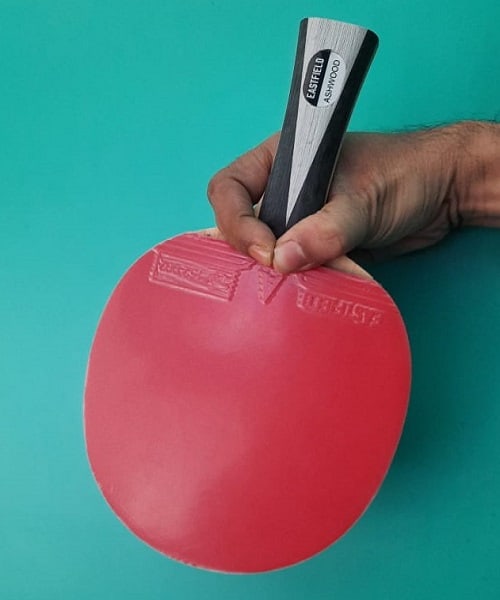

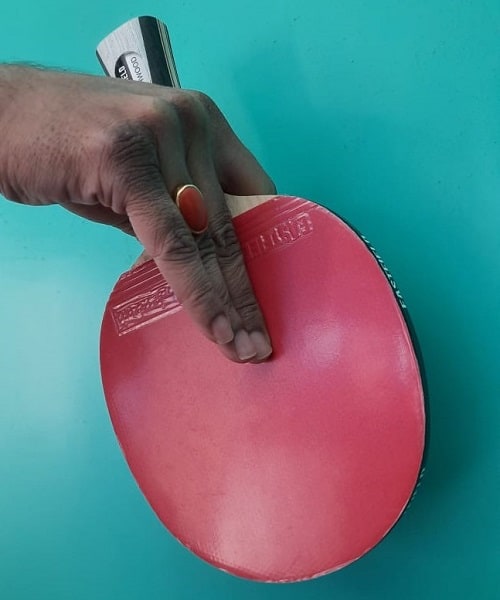
- You have to curl the index finger and thumb around the edge of the paddle to form a ‘c’ shape and relax on one side of the rubber.
- The other three fingers act as support on the other side of the rubber. When they are curled to rest on the rubber, it is the Chinese Penhold grip and when the fingers are straight, it is the Japanese Penhold grip.
Each type of grip has certain advantages and disadvantages against the other that you will find in my article “Table Tennis Grips: How to Hold a Racket“
In my view, the Shakehand grip is the more convenient way to hold a racket for a beginner.
3. Develop Stance and Ready Position
Before the ball is in play, you have to be ready with your stance.
- Stand close to the table.
- Your legs should be slightly apart from your shoulders.
- Bent your knees to make your center of gravity low for a good balance.
- Forward your shoulders slightly with the racket in front of your body.
- Your weight should be on your toes, not on the heels.
- Point your free arm to support your balance.
Take your stance with your left foot slightly forward than the right foot (for the right-handers). As you will cover more strokes on the forehand side, this stance will give you more advantage.
The ready position is the position where you feel comfortable standing to cover the playing area. It is the position where you take your stance to receive the service.
After playing a shot during a rally, you should return to your ready position. From this position, you should watch your opponent’s movement and be able to move in any direction for the next stroke.
Take your stance slightly left from the center of the table as it is easy to cover the area on your forehand side. For a left-hander, the stance is slightly right from the center of the table.
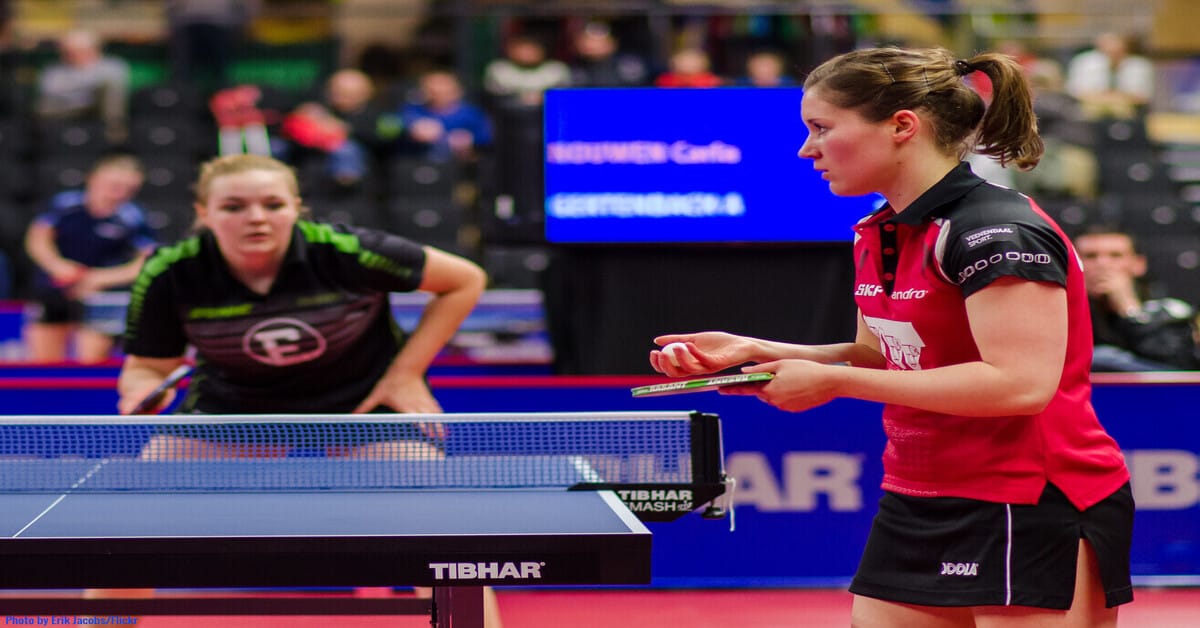
4. Develop Footwork in Table Tennis
The development of proper footwork is also necessary for the game of table tennis.
- It will help to cover a wide area for the execution of your strokes.
- You can produce a wide variety of shots accurately.
- You can reach near the ball in quick time which will give you more control over your strokes.
- It will help to maintain your balance during the play.
- You can also return to the ready position quickly and prepare for the next stroke.
There are four types of footwork in table tennis.
- In-and-out Footwork
- Side-to-side Footwork
- Cross-over Footwork
- One-step Footwork
In and Out Footwork
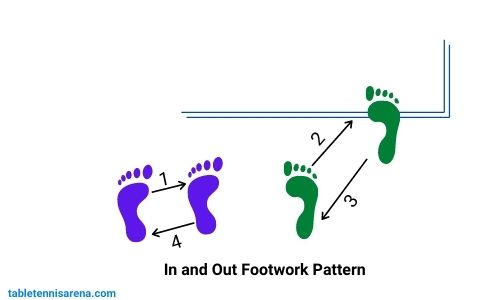
This type of footwork comes into action when you face a short return or a short service. At that time, you have to come closer to the ball to perform your return shot. Also after the stroke, you have to return to your ready position.
First, move your left foot and then your right foot will go near the ball. At the time of returning to your ready position, step your right foot first and then your left foot. For left-handers, the process is just the opposite.
Side to Side Footwork
During a rally, most often you have to move sideways, i.e. from the backhand side to the forehand and from the forehand side to the backhand.
To move sideways, take a small side-to-side shuffle. Your shuffling steps should be quick enough so it looks like a jump.
To move from backhand to forehand from your ready position, move your left foot first and then your right foot. Complete the shuffle by moving again your left foot and then your right foot.
To move from forehand to backhand from your ready position, move your right foot first and then your left foot. Complete the shuffle by moving again your right foot and then your left foot. This footwork is for the right-handers.
For left-handers, this side-to-side footwork technique is just the opposite.
Cross over Footwork
There are many times when you have to cover a wider area to return a ball, at that time you have to opt for cross-over footwork.
If you are a right-hander, then to get to a wide forehand position, take a wide step of your left foot. And then supporting your left foot as it is a pivot, place your right foot wide enough to get to the position for making the stroke.
One Step Footwork
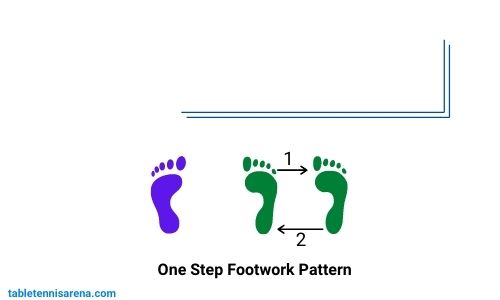
When the ball is a little away from you, you can use one-step footwork to reach near the ball for the execution of your stroke.
In this footwork, using the left foot as a pivot, move your right foot to reach near the ball, and after making the stroke, take the right foot back to the ready position to complete the stroke.
5. Backhand Push, 1st Basic Stroke
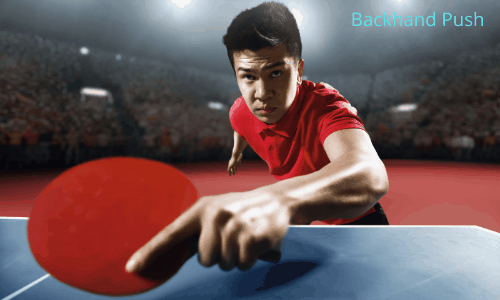
Push is the easiest stroke to return a ball and a beginner should start with the backhand push. The backhand push gives you the option to return a serve or continue a rally by slicing the ball with the backhand side of your racket.
- In this stroke, you should take a square-on stance on the table with slightly bent knees and the upper part of the body leaning forward.
- Your legs should be more apart than your shoulders.
- Your racket should be in front of your body.
- The backhand part of the racket should be open tilting backward and pointing towards the net.
- Push the racket to strike underneath the ball and forward towards the net or the table depending upon the return you will encounter.
Your push should be soft, if you try to push hard, the ball will fly over the table. Return to the ready position for the next stroke.
6. Learn Forehand Drive, 2nd Basic Stroke
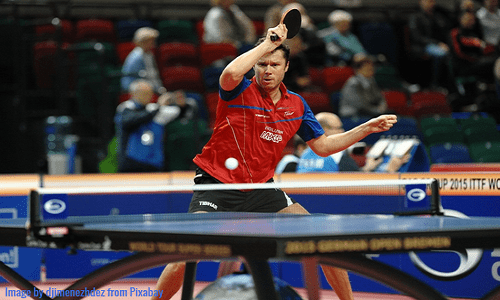
The forehand drive is the 2nd basic stroke that will build your base to control the ball during a rally.
- In this stroke, you should take a side-on stance to the table with slightly bent knees and the left leg slightly forward than your right leg (for right-handers).
- Your bat should be at the hip height facing towards where you want to place the ball.
- As the ball approaches, move your bat in an upward and forward direction.
- Hit the ball at the top of the bounce with the forehand side of your racket.
- Forward your bat up to eye level, not crossing the center of the body.
- Return to the ready position and prepare for the next stroke.
7. Backhand Drive, 3rd Basic Stroke
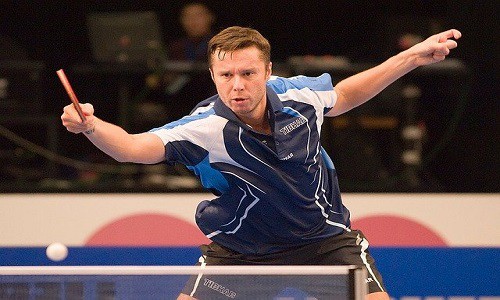
The backhand drive is not as powerful a stroke as the forehand drive. But it is essential learning that helps you continue the rally from your backhand portion.
- First, take a square-on stance facing towards where you want to hit the ball.
- Take the racket back towards you with the backhand side at an angle of 45° – 60° facing toward the direction you want to hit.
- As the ball approaches you, forward your arm in an upward direction maintaining the racket angle.
- Strike the ball at the top of the bounce and follow up to your shoulder height.
- Your striking length and follow-up length of stroke should be almost the same.
- Return to the ready position and prepare for the next stroke.
8. Forehand Push, Last Basic Stroke
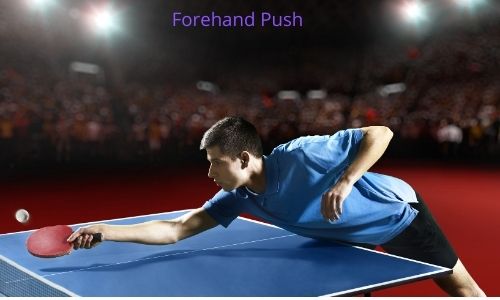
The forehand push is a soft stroke that is useful to return a short ball on your forehand side.
- Take a square-on or slightly side-on stance with your legs apart from your shoulders.
- Your playing hand should be next to you with the forehand side of the racket laid back.
- As the ball approaches, push your bat to cut underneath the ball at the top of the bounce.
- Your wrist, hand, and forearm are the main anchors for the pushing action.
- Return to the ready position for the next shot.
9. Know the Basic Service Rules for Singles Game
Like every racket sport, there are rules in table tennis governed by ITTF (International Table Tennis Federation).
As a beginner, it is not necessary to know all the rules. Here, I am giving you an idea of the essential rules that will restrict you from doing illegal services.
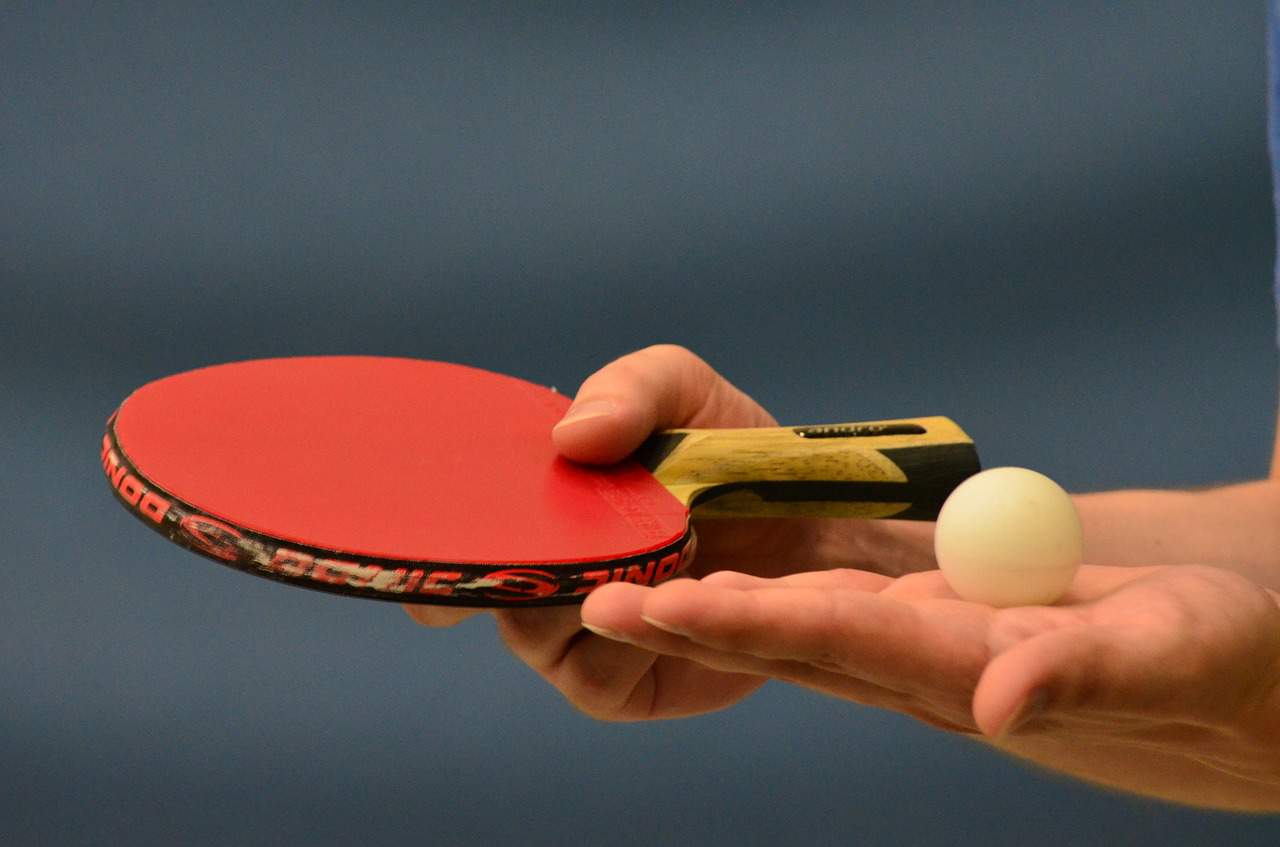
- Stand behind the end line of the table and take the ball on your open, flat palm.
- Through the ball vertically for a minimum height of 16 cm or 6.3 inches.
- At the time of falling, hit the ball for the first bounce on your court and the second bounce on the other side of the court after crossing over the net.
- After bouncing on your side, if the ball clips the net and bounces on the other side, it is a “let” service and then you have to repeat your service.
- Each player gets the chance to do two consecutive services.
10. Know the Service Rules for Doubles
When you will play a doubles match, there are some deviations from the service rules for a singles game.
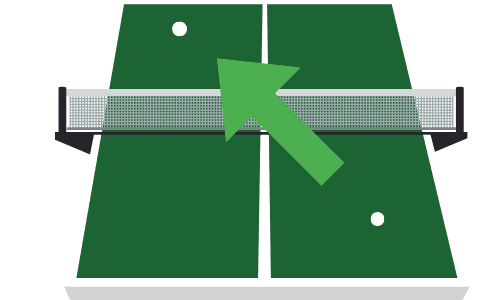
- When you will serve for your doubles team, you have to serve diagonally, from the right side of your court to the right side of your opponent’s court.
- After your two consecutive services, the receiver will become the server and your partner will play his role as a receiver.
If you want to know the details of the service rules, you may go through my article “Table Tennis Serving Rules: How to Serve Legally“
11. Table Tennis Rules for Singles, an Essential Learning
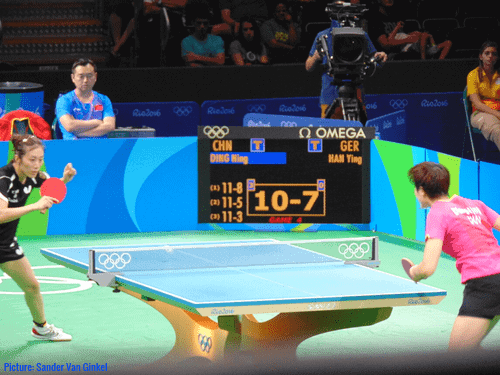
The rules are a very important segment of your quarry on “How to play table tennis”. To win points, you have to obey these rules. First, I am covering the essential rules for a singles game.
- When you will return a ball, strike the ball only after the first bounce on your side.
- The first bounce of your return must be on the opponent’s court.
- If the ball touches the net but still makes the first bounce on the other side, it is a valid return.
- The ball is allowed to touch the edge of the table but not the vertical side of the table.
- The game consists of 11 points and it is tied at 10-10, a two points lead is a must to win the game.
- A match consists of 3, 5, or 7 games.
12. Know the Rules for Doubles Game
Every rule for the doubles game in table tennis is the same as the singles game except following deviations.
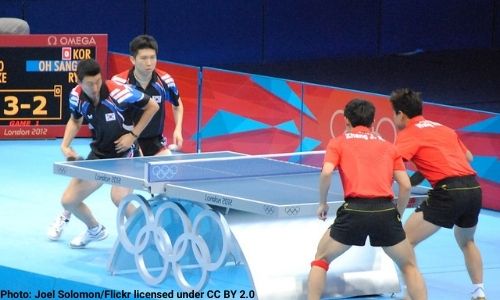
- In a doubles match, each player of the pair strikes the ball alternatively.
- During a rally, play must continue in its sequence until a player of any team misses hits the ball.
If you want to dive into the details of table tennis rules:
Read: 1. “Table Tennis Rules for Singles and Doubles Game“
2. “Scoring in Table Tennis: How to Score in a Game“
13. Learn the Basic Serve
In the game of table tennis, every point in a set starts with the service. At the time of the service, you have control of that point. You can serve in a way that forces your opponent to do a weak return or he may be bound to place the ball to your strong side. So it is very essential to learn the techniques for a good service.
As a beginner, you should start with two basic services, the forehand service, and the backhand service.
1. Forehand Serve
As a beginner, at first, try to hit the ball with your forehand side of the racket to make the first bounce on your court and the second bounce on your opponent’s court.
As you get habituated to doing it consistently, then try to vary the length and pace of your serve.
Then try to bounce the ball as low as possible over the net to restrict your opponent from doing a strong return.
PingSkills has a great video on the basic forehand serve.
2. Backhand Serve

In the backhand table tennis serve, you have to hit the ball with the backhand side for the first bounce on your side and the second bounce on the other side. Then repeat the procedures as described in the forehand serve.
After covering these two basic services, there are a lot of things to learn in the advanced part of serving.
The serve in table tennis is a vast subject. When you upgrade yourself from the beginner’s level, you have to learn the various serving techniques and for this, you have to clear the concept of spin in table tennis which is the major contributor to good service.
14. Learn the Techniques to Return a Ball
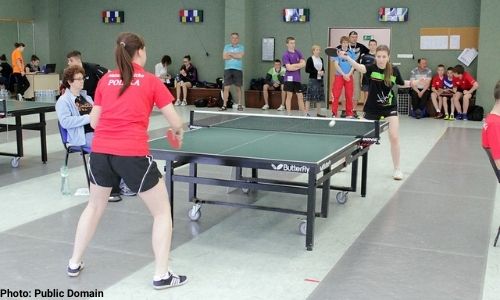
There are various options for returning a serve. But as a beginner, you should only rely on push or drive to return the service or continue the rally.
- To return a short service, only use the push stroke, it may be a backhand push or a forehand push.
- For long service, you may use the push stroke or the drive stroke.
- Try to keep the ball low over the net for an effective return.
For advanced skills, read: “How to Execute Different Strokes in Table Tennis“
15. Play Frequent Matches
You may be a very good player, but it’s a different ball game in the match. You will feel the tension and nervousness.
The more you will be tensed, the more you will commit mistakes. Your opponent may also tease you. Like, when your shots go out of the table, he may shout “Good shot, man”. That will tempt you to go for more attacking shots which never bring good results.
To get out of these situations, take a break. Take a deep breath and relax. Remember the magic words “I can, I will, I must!”. That will change the whole scenario.
You need to play frequent matches to handle this situation.
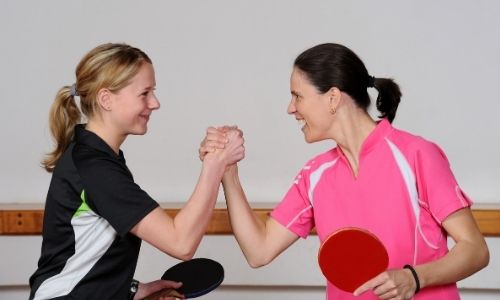
Practice, Practice, and Practice
This is the most vital recommendation on the “How to play table tennis“, that is “Practice, Practice, and Practice”. There is no alternative to hard work in this world. The more you practice, the more it will be easy to upgrade yourself in the game of table tennis.
And if are taking the game for recreation, then this wonderful game of table tennis has a great effect on keeping you physically and mentally fit.
FAQ
Table tennis is one of the racket sports that is played over a playing surface, known as a table tennis table, divided into equal parts by a net. A racket is used to strike a lightweight small ball, known as a ping pong ball over the net to bounce on each side of the ball following the table tennis rules.
No, they are not the same. They were the same before 2011. But from the year 2011, they are different sports with a slight difference in rules. For the equipment part, only the rackets are different. We use the term ping pong when we consider the game for recreation and competition, it is table tennis.
For details, you may go through the article “Ping Pong Vs Table Tennis: Are They Different Games?“
You have to reach 11 points to win a game. But if the game arises to a situation of 10 – 10, a two-point lead is necessary to win the game.
Each player (for the singles game) or each pair (for the doubles game) will get the chance for two consecutive serves till the game ends at 11 points. But if the game is tied at 10 – 10, the service alternates for each player or pair.
In the case of the singles game, the answer is “No”. You can stand anywhere to deliver your service. But in a doubles game, you have to bounce the ball diagonally from the right-hand portion of your side to the right-hand portion of your opponent’s side.
There is no limit on the number of “let” serves unless it is an illegal service.
Each side of the racket has a different color. One side is red colored and the color on the other side is black. But from October 2021, one side of the racket will be black and you have the option to use various colors on the other side like green, pink, purple, red, and blue.
